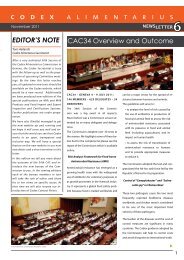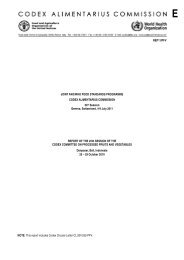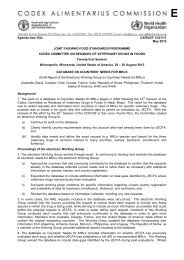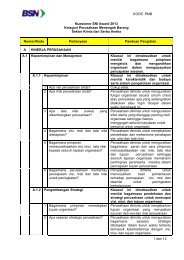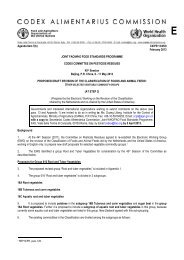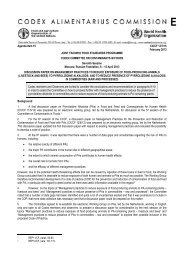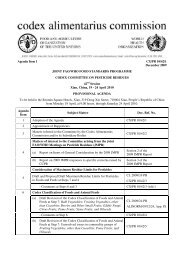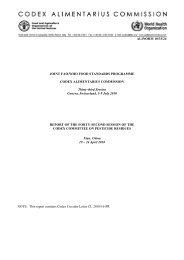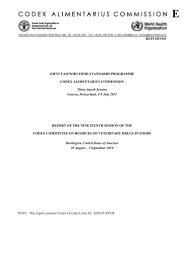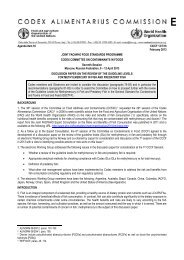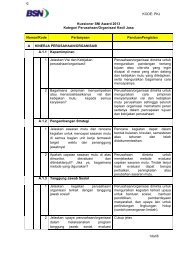CX/CF 13/7/5 Add.1 - FAO.org
CX/CF 13/7/5 Add.1 - FAO.org
CX/CF 13/7/5 Add.1 - FAO.org
- No tags were found...
You also want an ePaper? Increase the reach of your titles
YUMPU automatically turns print PDFs into web optimized ePapers that Google loves.
<strong>CX</strong>/<strong>CF</strong> <strong>13</strong>/7/5 <strong>Add.1</strong> 3REPUBLIC OF KOREAThe Republic of Korea supports the proposed draft maximum levels for lead.RUSSIAN FEDERATIONPosition:Sharing the concern of the toxic effect of lead on the population (especially for children), we suggest it is necessary to continue workto obtain more complete data of the lead content in these foods taking into account the data from Russian Federation.Rational:We consider the revised data for ML of lead content in some foods are more strict and their adoption is to be premature.URUGUAYUruguay is grateful to have the opportunity to present these comments on document <strong>CX</strong>/<strong>CF</strong> <strong>13</strong>/7/5: Proposed Draft Revision of theMaximum Levels for Lead in selected Commodities in the General Standard for Contaminants and Toxins in Food and Feed(CODEX STAN 193-1995): fruit juices, milk, infant formula, canned fruits and vegetables and cereal grains (except buckwheat,cañihua and quinoa) (at Step 3).Paragraph 35.Concerning the recommendations in the document, Uruguay has the following comments-Recommendation 1 - Although our ruling establishes 0.05 mg/kg, according to data collected from local products and by themethodology used, we have no problem with lowering the value to 0.03 mg/kg.Recommendation 4 - We have no objections to this recommendation.Recommendations 2, 3 & 5 - We have no comments on these.AFRICAN UNIONAfrican Union DOES NOT support theproposed lowering of MLS for lead by twofolds in fruits juice (from 0.05mg/kg to0.025mg/kg) and infant formula 0.02mg/kgto 0.01mg/kg) and by ten folds for cannedfruits (1.0mg/kg to 0.1mg/kg) andvegetables (1.0mg/kg to 0.1mg/kg).However, we AGREE that the current MLsfor milk (0.02mg/kg) and cereals (0.2mg/kg)be maintained.Although African Union DOES NOTsupport the proposed lowering of the ML forinfant formula, we do support therecommendation to add a note in thenote/remarks column in the GSCTFF thatthe ML of 0.02mg/kg also applies topowdered formula with a dilution factor.The reason for establishing MLs is to protect the health of the consumer worldwide,in this case from lead which has been associated with a wide range of adversehealth effects including various neurodevelopmental effects, impaired renal function,hypertension, impaired fertility and adverse pregnancy outcomes. Due to theneurodevelopmental effects, foetuses, infants and children are the most vulnerableto lead. However, when data used to revise MLs have narrow geographicalrepresentation then the objective of setting world standards is defected. The MLs forfruits juice, infant formula, and canned fruits and vegetable were revised withoutconsideration of lead contamination status in Africa.Mali was the only African country that contributed 99 of the 9080 results analysed toreach the decision to uphold the current MLs for cereals. This makes the decisioncredible with regards to geographical representation and so gains our support.The absolute lack of data from the continent on levels of lead in milk, fruits juice,canned fruits and vegetables underscores the need for Africa to support researchesat regional laboratories that would generate valid data that will meet worldstandards.The footnote is necessary to address situation where infant formula is marketed inliquid form (ready-to-eat)FOODDRINKEUROPEFRUIT JUICE (§12-15) 1There is a general concern with lead maximum limits set below 0.05 mg/kg for fruit juices. Using methods of analysis with a lowerLOQ of 0.01 mg/kg is achievable globally but not always current practice. Many existing standard laboratory methods have an LOQof 0.05 mg/kg for commodities such as fruit juice, concentrate and purees due to EU limits for fruit juices being set to 0.05 mg/kg.Applying another method with a lower LOQ (down to 0.01 mg/kg) would result in a financial impact where there are no safetyconcerns with the current higher 0.05 mg/kg maximum limit.1It is our understanding the current proposal applies not only to fruit juices and nectars but also to reconstituted juices, purees and concentratedpurees.




